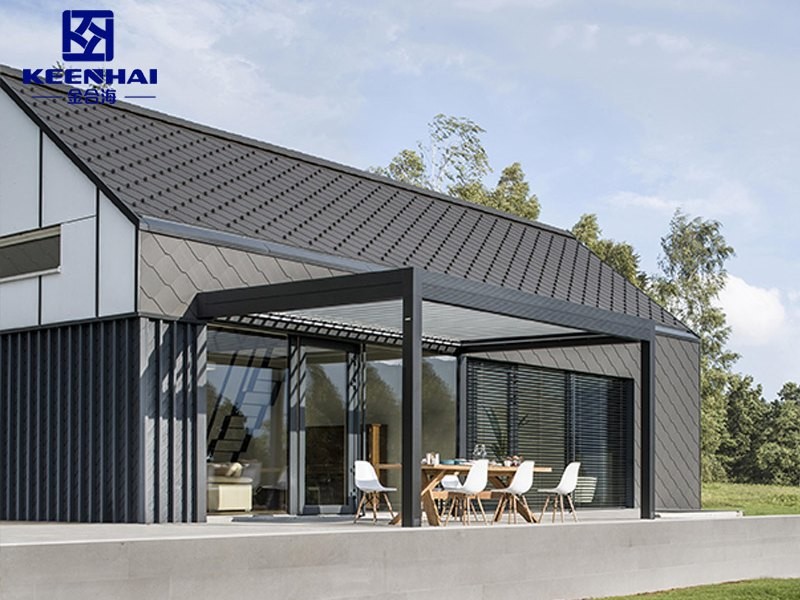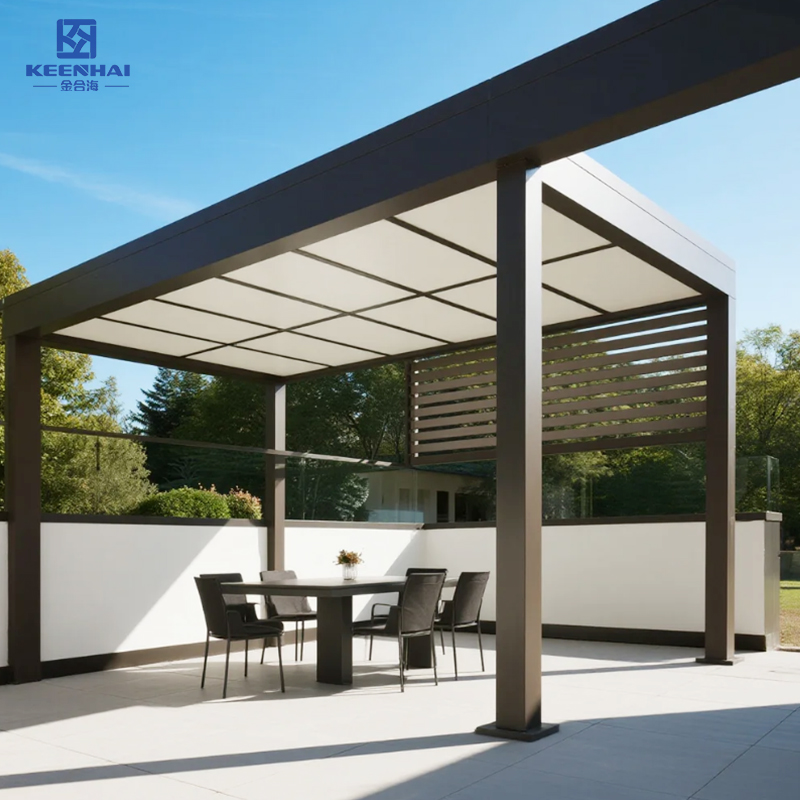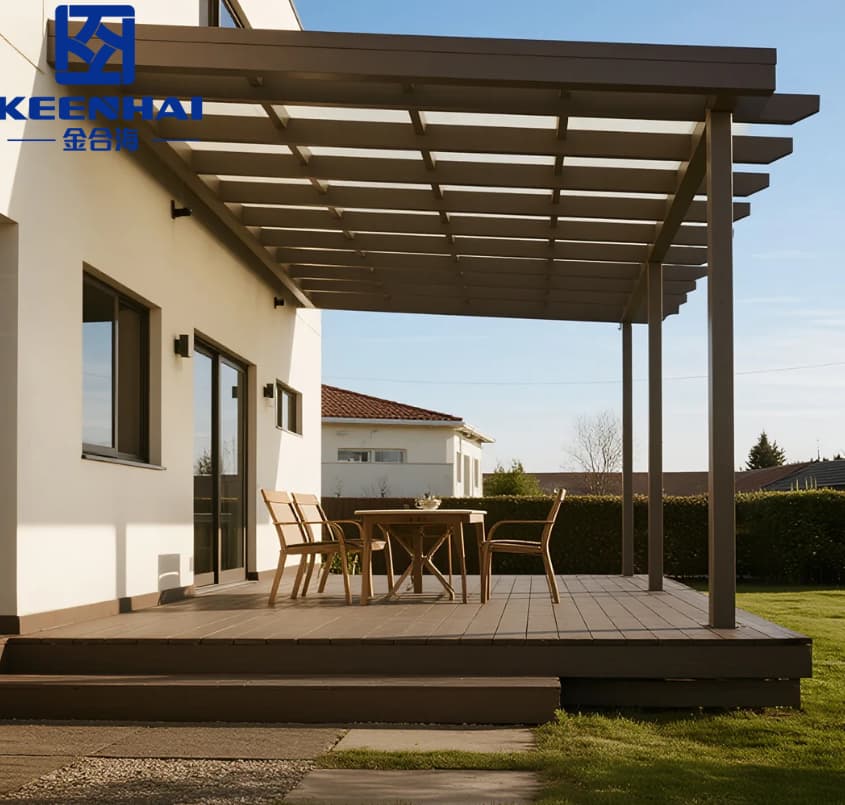
1.Cost vs. Value of Aluminium Pergolas
1.1 Initial Purchase Price and Installation Costs
When considering an Aluminium Pergola, the initial investment is usually higher than basic wooden pergolas but offers superior long-term benefits. A standard 10x10 ft aluminium pergola typically costs between $2,500 and $4,500, while fully customized 12x14 ft models with retractable roofs, LED lighting, or privacy panels can exceed $6,000.
Installation is straightforward for professionals and can even be a DIY project for two people, taking about 2–3 days for a standard-sized pergola. For example, a homeowner in Austin installed a 12x12 ft aluminium pergola next to their patio in just 3 days with two helpers, saving both time and labor costs compared to hiring a full crew.
1.2 Long-Term Maintenance Expenses
Aluminium pergolas shine when it comes to maintenance efficiency. Unlike wood, which demands annual sanding, staining, or sealing, aluminium only needs a rinse with water once or twice a year to maintain its appearance. Steel pergolas are stronger than wood but are prone to rust if coatings fail, adding long-term upkeep costs.
| Pergola Type | Annual Maintenance Effort | Estimated Cost Over 10 Years |
|---|---|---|
| Aluminium Pergola | Low | $100 – $200 |
| Wood Pergola | High | $1,000 – $1,500 |
| Steel Pergola | Medium | $500 – $800 |
A homeowner in Miami reported that after three years, their aluminium pergola remained as good as new, while their neighbor’s wooden pergola required annual sanding and repainting. This low-maintenance aspect significantly reduces ongoing expenses, making aluminium a smart long-term choice.
1.3 Resale Value Impact
Adding an aluminium pergola can positively influence your home’s resale value. Buyers often perceive them as durable, low-maintenance, and visually appealing additions to outdoor spaces. Their modern look and ability to integrate lighting, retractable roofs, or side panels enhance both comfort and aesthetic appeal.
Consider a property in Dallas with a 12x12 ft aluminium pergola installed beside the pool. During resale, the pergola attracted attention from buyers and contributed to a higher perceived value, as opposed to a comparable wooden pergola, which was seen as high-maintenance. Investing in aluminium provides both lifestyle and financial benefits, making it a choice that pays off in multiple ways.
While the upfront cost may seem high, the combination of installation convenience, minimal maintenance, and enhanced resale appeal ensures that an aluminium pergola offers real, measurable value over time.

2.Durability and Weather Resistance
2.1 Aluminium vs. Wood and Steel Comparison
When it comes to outdoor structures, material choice directly affects durability. An Aluminium Pergola offers superior strength and low maintenance compared to wood or steel. Wood looks classic but is prone to warping, cracking, and termite damage over time. Steel is strong but may rust if coatings fail, especially in humid or coastal environments. Aluminium combines lightweight construction with resistance to corrosion, making it a reliable long-term option for any backyard.
2.2 Resistance to Rust, Rot, and Pests
Aluminium naturally resists rust, rot, and pests, which gives it a significant edge over other materials. Wood pergolas often need yearly sealing and treatment to prevent decay or termite infestation, while steel requires protective coatings that can chip or wear over time. For homeowners in coastal cities like Miami or Los Angeles, an aluminium structure withstands salt air and humidity without special maintenance.
Consider this example: a family installed a 12x14 ft Aluminium Pergola beside their pool. After two summers of intense sun, heavy rain, and occasional storms, the pergola remained structurally sound and free of rust, whereas a neighbor’s wooden pergola required multiple touch-ups during the same period.
2.3 Lifespan in Different Climates
Aluminium pergolas perform consistently across diverse climates. In colder regions, they won’t warp or crack under frost, unlike wood. In hot climates, they remain stable under direct sunlight and don’t require repainting. Coastal areas benefit from aluminium’s natural corrosion resistance, while steel structures may need repeated protective coatings.
Here’s a quick lifespan comparison across materials and climates:
| Material | Hot Climate Lifespan | Cold Climate Lifespan | Coastal/Humid Lifespan |
|---|---|---|---|
| Aluminium Pergola | 20–25 years | 20–25 years | 20–25 years |
| Wood Pergola | 8–12 years | 10–15 years | 5–10 years |
| Steel Pergola | 15–20 years | 15–20 years | 10–15 years |
A homeowner in Chicago installed a 10x12 ft aluminium pergola last spring. Even after heavy snow and wind, the structure maintained its shape and finish, proving its adaptability across seasons. The same aluminium frame in a coastal California backyard resisted salty air and didn’t show any signs of corrosion after three years.
Choosing an aluminium pergola guarantees consistent durability and weather resistance, ensuring your outdoor space remains functional and attractive regardless of climate, which naturally leads into considering long-term value and maintenance benefits.

3.Design Flexibility and Customization
3.1 Size, Shape, and Style Options
One of the biggest advantages of an Aluminium Pergola is the flexibility it offers in size, shape, and overall style. Unlike wood, which can be limited by available timber dimensions and prone to warping, aluminium allows you to create perfectly straight lines, sleek modern angles, or even curved and intricate patterns without compromising structural integrity. Homeowners can choose anything from a compact 8x8 ft backyard setup to expansive 20x15 ft entertaining areas.
The shapes are not just aesthetic—different designs can maximize shade, airflow, or privacy. For example:
-
Rectangular pergolas are ideal for aligning with patios or decks.
-
L-shaped or U-shaped designs can enclose an outdoor lounge or dining area.
-
Freestanding round or hexagonal aluminium pergolas serve as focal points in gardens.
To give you a concrete comparison of common options and their suitability for various spaces:
| Pergola Shape | Best Use Case | Average Size Range |
|---|---|---|
| Rectangular | Decks, patios | 10x10 – 20x15 ft |
| L-Shaped | Outdoor dining/lounge | 12x12 – 20x20 ft |
| Hexagonal/Round | Garden focal points | 8x8 – 12x12 ft |
A homeowner in Los Angeles installed a 12x16 ft Aluminium Pergola over their poolside lounge. The custom L-shaped design allowed seamless integration with both seating areas and outdoor planters, giving the backyard a unified, luxurious look without feeling crowded.
3.2 Integration with Outdoor Furniture and Landscaping
A well-designed aluminium pergola is not just a standalone structure—it should complement existing landscaping, furniture, and pathways. Modern aluminium frames are versatile enough to align with pergola curtains, lounge seating, outdoor kitchens, or even fire pits. For example, a 10x12 ft Aluminum Modern Gazebo can be positioned to cover a dining table and outdoor sofa, providing shade and shelter while keeping the area visually open.
Steps to integrate a pergola with furniture and landscaping effectively:
-
Measure the space carefully to ensure your pergola doesn’t block garden flow or doorways.
-
Choose complementary furniture—lightweight, weather-resistant pieces work best under aluminium structures.
-
Plan lighting and greenery—hanging planters or string lights can enhance ambiance without clutter.
-
Leave clearance for movement—at least 3–4 ft around furniture to maintain comfortable circulation.
A family in Miami installed a 14x12 ft Aluminum pergola house over their outdoor dining and grill area. They incorporated planters along the perimeter and recessed LED lighting into the frame, creating a cohesive outdoor room that seamlessly connects with their landscaped backyard.
3.3 Add-Ons: Retractable Roofs and Accessories
Customisation extends far beyond shape and placement. Modern aluminium pergolas can include retractable roofs, side screens, ceiling fans, LED lights, and even sound systems, turning any backyard into a functional, all-season space. A retractable roof allows homeowners to control sun exposure, open up the sky during pleasant weather, or protect furniture during rain.
Installation tips for add-ons:
-
Retractable roof – choose durable fabric rated for UV and water resistance; professional installation ensures smooth operation.
-
Side screens or panels – ideal for privacy or wind protection; ensure proper tension and anchoring.
-
Lighting and ceiling fans – use outdoor-rated wiring and fixtures; LED strips can be embedded into beams for subtle effects.
-
Decorative accessories – hanging planters or curtains can personalize the space without affecting structural integrity.
A backyard renovation in San Diego featured a 12x14 ft Aluminium Pergola with a retractable roof and side panels. The homeowners could enjoy full sun in the morning and shade in the afternoon, while integrated LED lighting allowed the space to serve as an evening lounge. This combination of flexibility and accessories demonstrates why aluminium pergolas are considered the most versatile outdoor structure available today.

4.Energy Efficiency and Comfort Benefits
4.1 Shade and Sun Protection
One of the most immediate benefits of installing an Aluminium Pergola is effective shade and sun protection. Aluminium’s reflective surface naturally deflects sunlight, keeping the area underneath cooler without absorbing heat like wood or steel. A well-positioned pergola can block up to 80–90% of direct sunlight during peak hours, allowing you to enjoy outdoor living without overheating or risking sunburn.
Homeowners often pair pergolas with retractable roofs or adjustable louvers to control sun exposure throughout the day. For instance, a 12x14 ft aluminium pergola installed over a poolside lounge in Los Angeles allows users to enjoy sun in the morning and shade in the afternoon, creating a flexible outdoor experience.
4.2 Ventilation and Heat Management
Aluminium pergolas also excel in natural ventilation, which reduces trapped heat beneath the structure. Open-beam designs allow hot air to rise and escape, while integrated louvers or gaps between beams promote airflow. This is particularly beneficial for urban backyards, where heat can accumulate quickly due to surrounding walls or concrete patios.
Steps to maximize ventilation:
-
Choose an open-beam or louvered design – allows air circulation while still providing shade.
-
Orient the pergola according to prevailing winds – positioning can enhance natural airflow.
-
Add ceiling fans or vents – for additional airflow on extremely hot days.
A family in Miami installed a 10x12 ft Aluminum Modern Gazebo over their outdoor dining area. Even during peak summer heat, the airflow between beams kept the space comfortably cool without additional fans, demonstrating how aluminium pergolas manage heat efficiently.
4.3 Potential Cooling Cost Reduction
By reducing direct sun exposure and promoting ventilation, aluminium pergolas can lower indoor cooling costs for adjacent areas. Homes with pergolas shading patios, decks, or windows often experience lower air conditioning usage, translating into measurable energy savings.
| Pergola Type | Shade Efficiency | Potential Cooling Cost Reduction |
|---|---|---|
| Aluminium Pergola | 80–90% | 10–15% annually |
| Wood Pergola | 60–70% | 5–10% annually |
| Steel Pergola | 70–80% | 7–12% annually |
A homeowner in Dallas installed a 14x12 ft Aluminium Pergola over a south-facing patio. Their monthly cooling costs dropped by approximately 12% in summer months, thanks to shade coverage and airflow management. This demonstrates that aluminium pergolas not only improve outdoor comfort but also provide long-term energy efficiency benefits.
Strategically designed aluminium pergolas provide shade, encourage natural ventilation, and can even reduce indoor cooling costs, making them a practical investment for both comfort and efficiency.
